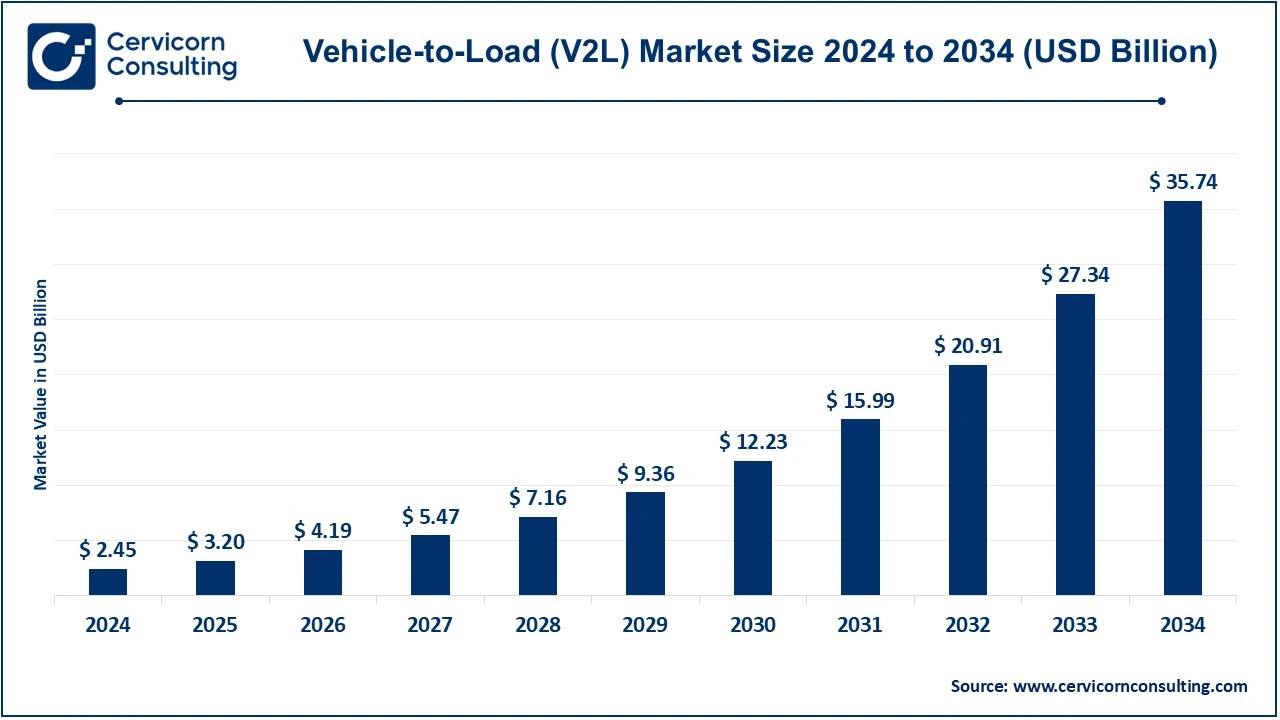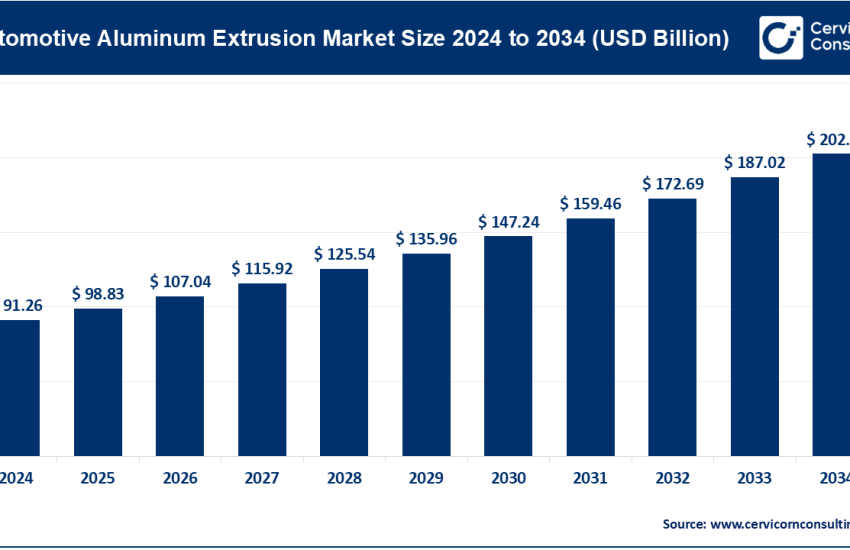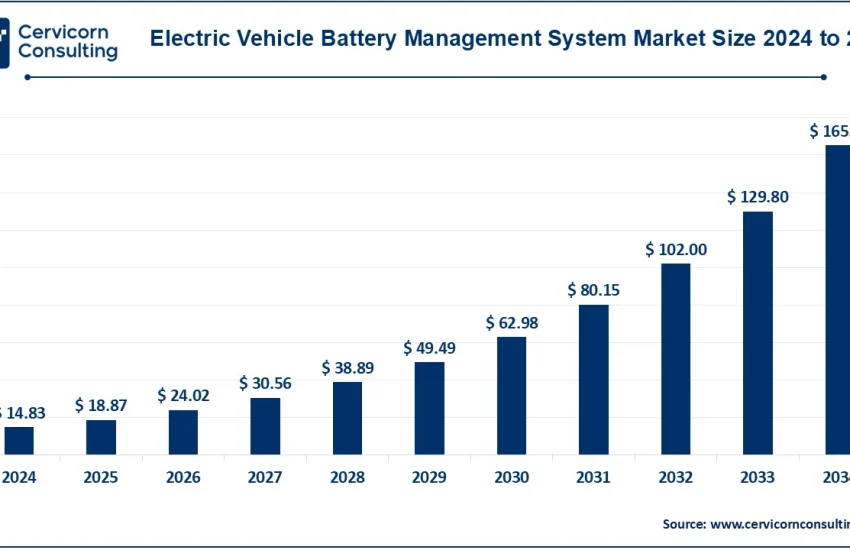Vehicle to Load (V2L) Market Revenue, Global Presence, and Strategic Insights by 2034
Vehicle to Load (V2L) Market Size
The global vehicle-to-load (V2L) market size was worth USD 2.45 billion in 2024 and is anticipated to expand to around USD 35.74 billion by 2034, registering a compound annual growth rate (CAGR) of 30.95% from 2025 to 2034.
What is the Vehicle-to-Load (V2L) Market?
Vehicle-to-Load (V2L) refers to the hardware and software ecosystem that enables electric vehicles to export power from their battery packs to external electrical loads. Unlike Vehicle-to-Grid (V2G), which focuses on feeding energy back into the electricity grid, V2L is oriented toward powering everyday appliances, tools, or even homes during power outages.
This capability can be integrated directly into EVs through built-in power outlets, adapters connected to the vehicle’s charging port, or bidirectional charging systems installed at homes or workplaces. The V2L market encompasses automakers, inverter manufacturers, charger providers, and energy service companies developing the infrastructure, protocols, and devices to make power export safe and seamless.
Essentially, V2L represents the convergence of the automotive, renewable energy, and smart-grid industries. By enabling EV batteries — typically ranging from 40 kWh to over 100 kWh — to function as portable power banks, V2L expands the role of vehicles into mobile microgrids.
Get a Free Sample: https://www.cervicornconsulting.com/sample/2561
Why the Vehicle-to-Load (V2L) Market is Important
The importance of the V2L market lies in its potential to enhance resilience, energy independence, and sustainability:
- Emergency Power Backup: V2L-enabled EVs provide crucial electricity during outages caused by natural disasters or grid failures.
- Outdoor and Off-Grid Applications: It allows users to power tools, camping equipment, and appliances at remote sites without relying on fossil-fuel generators.
- Grid Flexibility: Although distinct from V2G, V2L is part of the broader bidirectional-energy ecosystem that supports distributed generation and grid balancing.
- Energy Optimization: When paired with renewable energy systems, V2L enables users to store excess solar power in an EV battery and reuse it later, reducing grid dependence.
- Enhanced EV Value: Offering V2L transforms EVs into multi-utility assets, increasing consumer appeal and creating differentiation in a competitive market.
In short, V2L empowers individuals, businesses, and communities to tap into cleaner, more reliable, and decentralized sources of energy.
Growth Factors Driving the V2L Market
The Vehicle-to-Load market is expanding rapidly, propelled by a confluence of technological, regulatory, and consumer trends. Rising EV adoption is increasing the availability of high-capacity batteries capable of powering external loads. Consumers are seeking vehicles that provide practical, lifestyle-enhancing features such as outdoor and emergency power use. Advances in bidirectional inverters, control electronics, and communication protocols have made power export safer and more affordable. At the same time, governments worldwide are funding research, pilot programs, and infrastructure that encourage V2X (Vehicle-to-Everything) technologies, including V2L.
The broader shift toward clean energy and grid resilience, combined with strategic partnerships between automakers, utilities, and energy service providers, is accelerating the commercialization of V2L capabilities worldwide. Together, these factors position the market for exponential growth over the next decade.
Top Companies in the Vehicle-to-Load (V2L) Market
Below are profiles of leading players that are shaping the global Vehicle-to-Load ecosystem through innovation, strategic investment, and market leadership.
1. Nissan Motor Corporation
Specialization:
Nissan is among the pioneers of electric vehicle technology, known for its early-generation Nissan LEAF — one of the first mass-produced EVs globally. The company has consistently explored bidirectional energy applications, including V2L and V2G.
Key Focus Areas:
- Integrating V2L functionality into mass-market EVs.
- Developing partnerships with energy companies and utilities for V2X pilots.
- Expanding battery technology and vehicle energy management systems.
Notable Features:
Nissan’s V2L-capable EVs can power appliances, tools, and even small homes. Its models demonstrate seamless interoperability between vehicle systems and household circuits for backup energy use.
2024 Revenue and Market Share:
In 2024, Nissan reported global revenue of approximately ¥10 trillion (around USD 65 billion). Its strong EV presence in Japan and Europe supports significant influence in the global V2L market.
Global Presence:
Nissan operates in over 160 countries, with V2L-related activities concentrated in Japan, Europe, and Australia — regions with established energy-storage initiatives.
2. Mitsubishi Motors Corporation
Specialization:
Mitsubishi Motors focuses heavily on plug-in hybrid electric vehicles (PHEVs), which combine electric propulsion with onboard engines for extended range. The company has leveraged this technology to integrate reliable V2L features in several models.
Key Focus Areas:
- Expanding V2L capabilities in PHEVs and SUVs.
- Enhancing user experience for off-grid and camping applications.
- Promoting V2L as a core differentiator in outdoor and emergency-power markets.
Notable Features:
The Mitsubishi Outlander PHEV is widely recognized for its onboard AC power outlets that deliver clean energy for appliances and outdoor equipment. These systems have been adopted across markets like Japan and Australia, where mobile power is highly valued.
2024 Revenue and Market Share:
Mitsubishi Motors recorded net sales of roughly ¥2.8 trillion (about USD 18 billion) in 2024. Its strong PHEV portfolio contributes a growing share of global V2L-enabled vehicles.
Global Presence:
The company maintains strong footholds in Asia-Pacific, Europe, and Latin America. Its vehicles are particularly popular in markets that prioritize outdoor lifestyles and grid resilience.
3. Groupe Renault
Specialization:
Groupe Renault, encompassing the Renault, Dacia, Alpine, and Mobilize brands, is a leading European automaker with a deep commitment to electrification and energy services.
Key Focus Areas:
- Electrifying mass-market passenger and commercial vehicles.
- Integrating V2L and bidirectional capabilities through the Mobilize brand.
- Partnering with utilities and municipalities for smart-energy pilots.
Notable Features:
Renault is developing V2L-enabled EVs designed for both consumer and professional use. The company is also exploring commercial-fleet applications where vehicle batteries can serve as backup energy for equipment or temporary sites.
2024 Revenue and Market Share:
Renault Group reported total revenue of about €56 billion in 2024, with automotive sales comprising the majority. Its electrified lineup positions it as a strong European contributor to the V2L ecosystem.
Global Presence:
Renault operates across Europe, Latin America, the Middle East, and Africa. Its commercial-vehicle division offers potential for large-scale V2L deployment across logistics and industrial sectors.
4. ENGIE Group
Specialization:
ENGIE Group is a global leader in low-carbon energy and energy-services solutions. The company operates across power generation, renewable energy, natural gas, and smart-energy systems.
Key Focus Areas:
- Integrating electric-mobility solutions with renewable energy.
- Developing large-scale V2G/V2L pilots with utilities and municipalities.
- Managing energy flexibility and distributed-generation projects.
Notable Features:
ENGIE’s innovation programs explore how EVs can provide backup or balancing power to smart grids and microgrids. The group collaborates closely with automakers to bring bidirectional-charging capabilities to commercial customers.
2024 Revenue and Market Share:
ENGIE Group reported annual revenue of roughly €74 billion in 2024. With its strong renewable-energy foundation, ENGIE plays a vital role in enabling large-scale adoption of V2L and V2X solutions.
Global Presence:
Operating in more than 70 countries, ENGIE’s projects span Europe, the Americas, Africa, and Asia. The company’s infrastructure scale and partnerships with local governments give it a decisive role in global V2L expansion.
5. OVO Energy Ltd.
Specialization:
OVO Energy is a major UK-based energy retailer and parent company of the energy-technology platform Kaluza, which specializes in distributed-energy management and smart-charging software.
Key Focus Areas:
- Developing intelligent EV-charging solutions integrated with home-energy systems.
- Enabling V2L and V2G participation for retail customers.
- Building digital platforms that optimize energy flows and tariffs for EV owners.
Notable Features:
OVO’s Kaluza platform enables dynamic energy management, smart tariffs, and real-time control of EV charging and discharging. It serves as a bridge between vehicle hardware and the energy market, supporting bidirectional energy use.
2024 Revenue and Market Share:
While smaller than global automakers and utilities, OVO maintains a strong market presence in the UK’s residential-energy sector, serving millions of customers. Its investment in software innovation positions it as a key facilitator of consumer-level V2L adoption.
Global Presence:
Primarily headquartered in the United Kingdom, OVO is expanding its software-as-a-service offerings into Europe and other regions through partnerships with energy providers.
Leading Trends and Their Impact on the Market
- Mainstream Integration of V2L Ports:
Automakers are increasingly offering V2L as a standard or optional feature in new EV models. Vehicles such as the Hyundai IONIQ 5, Nissan LEAF, and Mitsubishi Outlander PHEV have set benchmarks for this trend. The impact is a broader consumer understanding of EVs as practical, multipurpose assets. - Growth of Bidirectional-Charging Infrastructure:
The rise of bidirectional home and commercial chargers enables users to export power safely to homes or businesses. This development bridges the gap between simple V2L functionality and advanced Vehicle-to-Home (V2H) or V2G systems, paving the way for integrated energy management. - Standardization and Interoperability:
Industry groups are working to standardize communication protocols and safety requirements for V2L/V2G systems. Greater interoperability reduces technical barriers, encourages competition, and ensures consumer safety. - Emphasis on Energy Resilience:
Governments and businesses are adopting V2L-enabled solutions to improve resilience during grid disruptions. These capabilities are proving essential in disaster-prone or remote regions. - Technological Advancements in Power Electronics:
Continuous improvements in inverters and control systems have enhanced the efficiency and reliability of bidirectional energy transfer. Better thermal management and real-time monitoring are extending battery lifespans and reducing warranty risks. - New Business Models:
Energy retailers and mobility providers are developing subscription services and tariffs that monetize V2L/V2G use. Such models will create recurring revenue streams for automakers and energy companies while giving consumers tangible financial benefits.
Successful V2L Implementations Worldwide
- Hyundai IONIQ 5 and 6:
These models feature built-in 230-volt AC outlets that can power appliances up to around 3.6 kW. They have become the public face of consumer-friendly V2L, popular among outdoor enthusiasts and families. - Nissan LEAF Projects in Japan and Europe:
The LEAF’s bidirectional capabilities have been tested extensively in community and emergency-response settings, proving how EVs can stabilize local grids and supply temporary power after disasters. - Mitsubishi Outlander PHEV in Australia:
Its V2L function supports household backup and outdoor power, making it one of the best-known PHEV examples combining driving range and energy flexibility. - ENGIE Group Demonstrations in Europe:
ENGIE has conducted numerous pilot projects integrating fleets of EVs to provide balancing energy and backup services, showcasing the business potential of large-scale V2L and V2G deployments. - OVO Energy and Kaluza Smart-Charging Programs:
OVO’s technology trials in the UK demonstrate how software platforms can optimize charging times and manage two-way energy flows for residential customers.
Global and Regional Market Analysis
Europe
Europe is one of the most advanced regions for V2L and bidirectional-charging technologies. The European Union’s “Fit for 55” package, combined with the Alternative Fuels Infrastructure Regulation (AFIR), has encouraged EV integration and smart-charging networks. Countries such as the Netherlands, Germany, and the UK have launched multiple government-funded pilots exploring how V2L and V2G can reduce grid congestion, balance renewables, and enhance consumer energy independence. Automakers like Renault and energy firms such as ENGIE are leveraging these initiatives to test real-world applications and establish commercial frameworks.
Japan
Japan has long been a leader in V2L and V2G adoption. Following the 2011 Fukushima disaster, the government promoted EVs as emergency power sources. National programs support V2L installations in public facilities and residential buildings. Domestic automakers like Nissan and Mitsubishi have fully integrated these capabilities into their vehicles, and utilities actively collaborate to expand the market. The Japanese model demonstrates how V2L technology can serve both consumer convenience and disaster resilience.
North America
In the United States and Canada, federal and state policies supporting electric mobility and grid modernization are driving interest in bidirectional energy solutions. The U.S. Department of Energy and various utilities are funding V2G/V2L research, emphasizing interoperability and safety. Although regulatory fragmentation across states poses challenges, the emergence of national charging standards and incentives for home energy storage is expected to accelerate adoption.
Asia-Pacific
Beyond Japan, countries such as South Korea, China, and Australia are rapidly integrating V2L-enabled EVs. South Korean automakers, notably Hyundai and Kia, have popularized V2L-equipped models in domestic and export markets. Australia’s outdoor culture and high solar-PV penetration make V2L features highly attractive for households and recreational use. Governments in the region are supporting pilot programs that merge EV charging with renewable generation and smart-grid management.
United Kingdom
The UK government, through Ofgem and Innovate UK, has funded multiple vehicle-grid-integration projects. Retailers such as OVO Energy play central roles by offering consumer-friendly tariffs and real-time control software. Policy momentum, combined with a competitive energy-supplier landscape, is fostering early commercialization of V2L and V2G solutions.
Rest of the World
Emerging markets in Latin America, Africa, and the Middle East are beginning to explore V2L technologies primarily through renewable-energy integration and disaster-relief projects. These regions view V2L as an opportunity to improve energy access, particularly in remote or under-electrified areas where mobile power sources can supplement unstable grids.
Implementation and Practical Considerations
While V2L technology offers immense promise, widespread adoption depends on addressing several practical issues:
- Technical Standards: Different vehicle connectors and charging standards (CHAdeMO, CCS, GB/T) need harmonization to ensure global compatibility.
- Safety Regulations: Exporting power from a vehicle must comply with national electrical codes and safety standards to prevent grid feedback or electrical hazards.
- Battery Degradation: Advanced battery-management systems now mitigate degradation risks associated with bidirectional energy flow, but warranty clarity remains essential.
- Infrastructure Investment: Installing bidirectional chargers or integrating V2L into homes requires certified equipment and professional installation, representing an initial cost barrier.
- Consumer Awareness: Education and marketing will play crucial roles in communicating the benefits and proper use of V2L features.
Summary
The Vehicle-to-Load (V2L) market sits at the crossroads of electric mobility and energy resilience. As automakers embed power-export capabilities into next-generation EVs and energy companies build supporting infrastructure, V2L is evolving from a niche innovation to a mainstream value proposition. Global policy frameworks, technological advancements, and cross-industry collaboration are collectively driving this transformation. With leading players such as Nissan, Mitsubishi, Renault, ENGIE, and OVO Energy paving the way, the coming decade will likely see V2L become a standard feature in electric mobility — enabling vehicles to power the world around them.
To Get Detailed Overview, Contact Us: https://www.cervicornconsulting.com/contact-us
Read Report: Hyperscale Data Center Market Revenue, Global Presence, and Strategic Insights by 2034



